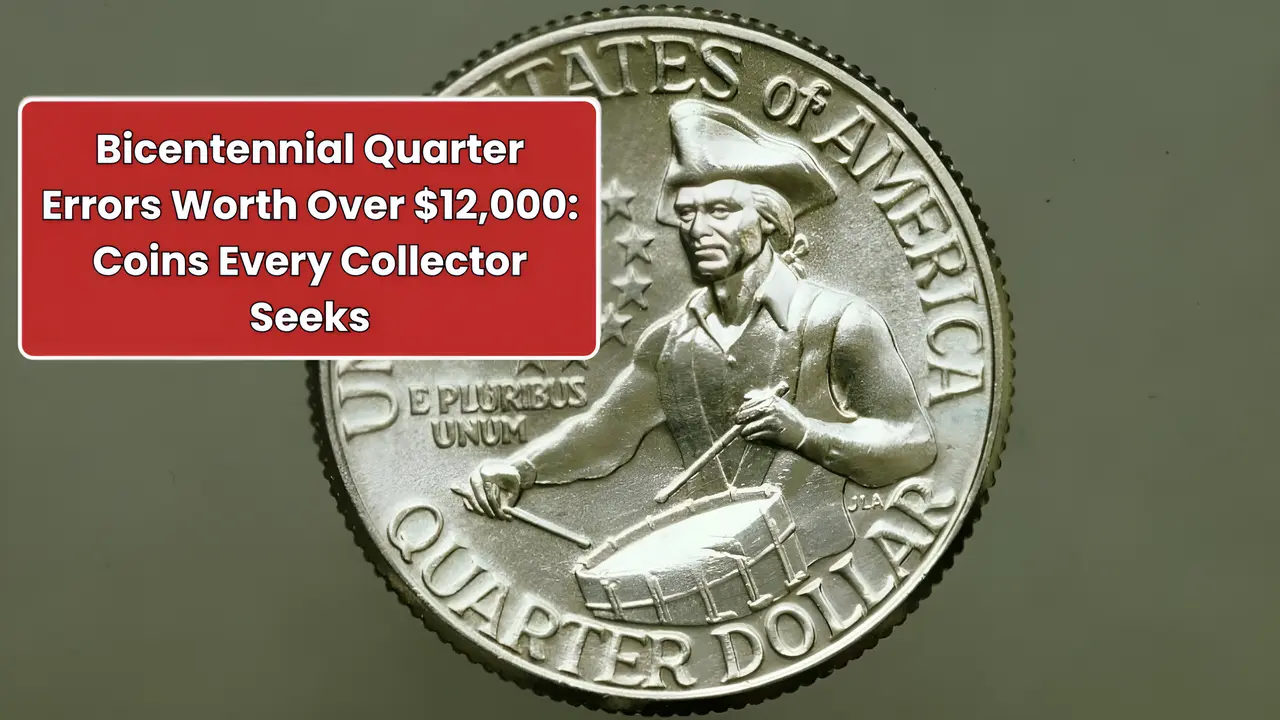Bicentennial quarters were made to celebrate the 200th birthday of the United States, and they are special not only because they mark this event but also because some coins have rare mistakes. These errors make the coins highly sought after by collectors, with some selling for more than $12,000. Whether you’re an experienced collector or just starting out, here’s what you need to know about these valuable coins and the errors to watch for.
What Makes Bicentennial Quarters Special?
These quarters were made in 1975 and 1976 to honor 200 years since the Declaration of Independence. They have a unique design on the back showing a colonial drummer boy and the dates “1776–1976.”
There are two main types: regular coins made of copper and nickel, and special collector coins made with 40% silver. Some of these coins are especially valuable because of rare mistakes that happened when they were made.
1. Double Die Obverse (DDO) Error
- What It Is: This happens when a coin is struck twice, causing parts of the design or text to appear doubled.
- Value: Depending on how clear the doubling is, these coins can sell for $500 to over $12,000.
- Why It’s Special: If the doubling is visible on the dates or inscriptions, it makes the coin much more valuable to collectors.
2. Off-Center Strikes
- What It Is: In this error, the coin is not aligned correctly during minting, so part of the design is missing.
- Value: These coins can sell for $1,000 to $5,000, depending on how far off-center they are.
- Why It’s Special: The more misaligned the design, the rarer and more collectible the coin becomes.
3. Clipped Planchet
- What It Is: This happens when a piece of the metal blank is missing before the coin is stamped with its design.
- Value: These coins are worth $500 to $2,000, depending on the size and location of the missing piece.
- Why It’s Special: The missing piece gives the coin a unique look that collectors find appealing.
4. Missing Clad Layer
- What It Is: Some coins are missing one of their outer layers, showing the copper core underneath.
- Value: Coins with this error can be worth $1,500 or more.
- Why It’s Special: The exposed copper gives the coin a distinct look, making it stand out among other Bicentennial quarters.
5. Die Breaks and Cuds
Why It’s Special: Since each die break is unique, these coins are highly collectible.
What It Is: These errors happen when the die used to strike the coin gets damaged, leaving raised or bumpy areas on the coin’s surface.
Value: Coins with die breaks can range in value from $100 to $1,000, depending on how large and noticeable the break is.
6. Proof Errors
- What It Is: Proof coins, made especially for collectors, sometimes have mistakes like designs struck through foreign objects or other unusual flaws.
- Value: These errors can sell for $2,000 to $10,000.
- Why It’s Special: Proof coins are usually made with extra care, so finding an error on one is very rare, which makes it highly valuable.
7. Transitional Errors
Why It’s Special: The error in metal or size makes these coins unique and highly desirable among collectors.
What It Is: Some Bicentennial quarters were mistakenly struck on metal blanks meant for other coins or made from the wrong material.
Value: These coins are extremely rare and can sell for over $12,000.
How to Identify Bicentennial Quarter Errors
To spot errors in your coins, examine them closely using a magnifying glass. Pay attention to details like doubled designs, missing layers, misalignments, or any unusual features. If you think your coin might have a valuable error, it’s a good idea to have it authenticated and graded by professional services such as PCGS or NGC. This can confirm its rarity and value.
FAQs
1. What is the most valuable Bicentennial quarter error?
The most valuable error is the transitional error, where the quarter was struck on the wrong metal or planchet. These coins can sell for over $12,000.
2. How can I tell if my Bicentennial quarter has an error?
Check your coin for unusual features like doubled designs, missing layers, off-center strikes, or odd shapes. Use a magnifying glass or microscope to spot these details.
3. Are all Bicentennial quarters valuable?
No, regular Bicentennial quarters used in circulation are usually only worth face value. Only those with errors or in mint condition are significantly valuable.
4. Where can I sell Bicentennial quarters with errors?
You can sell error coins to coin dealers, through auctions, or on platforms like eBay. Grading your coin first can increase its value.
5. How much does it cost to grade a Bicentennial quarter?
Grading fees depend on the coin’s value and the service provider, typically ranging from $20 to $100. For rare coins, grading is a good investment.
6. Why are error coins valuable?
Error coins are unique and rare, created by mistakes during the minting process, which makes them highly collectible.
